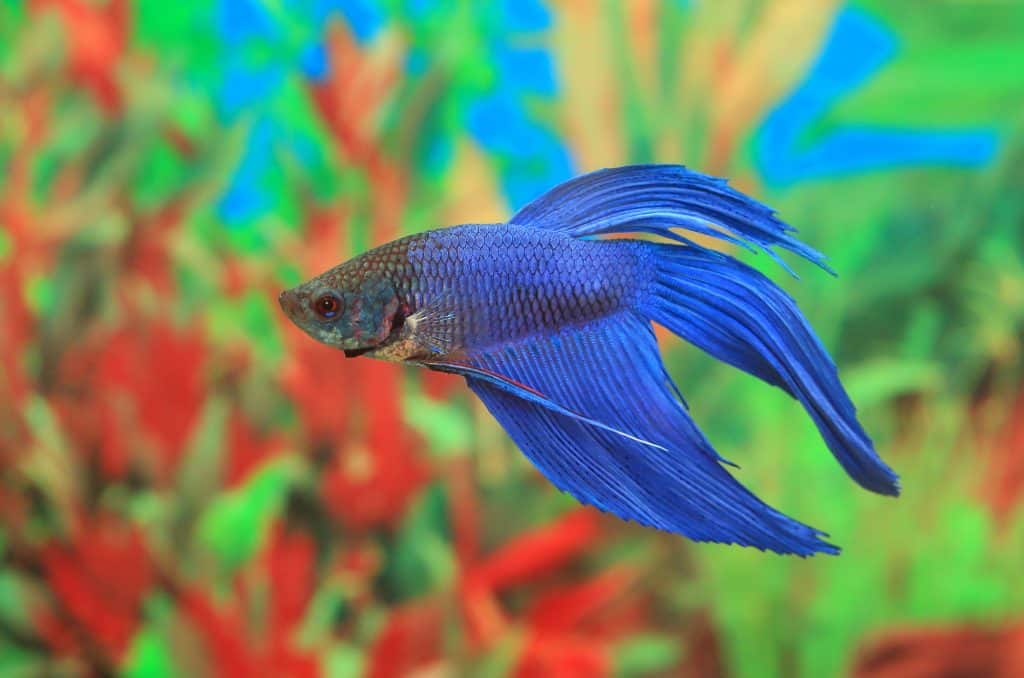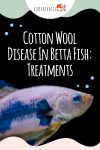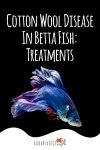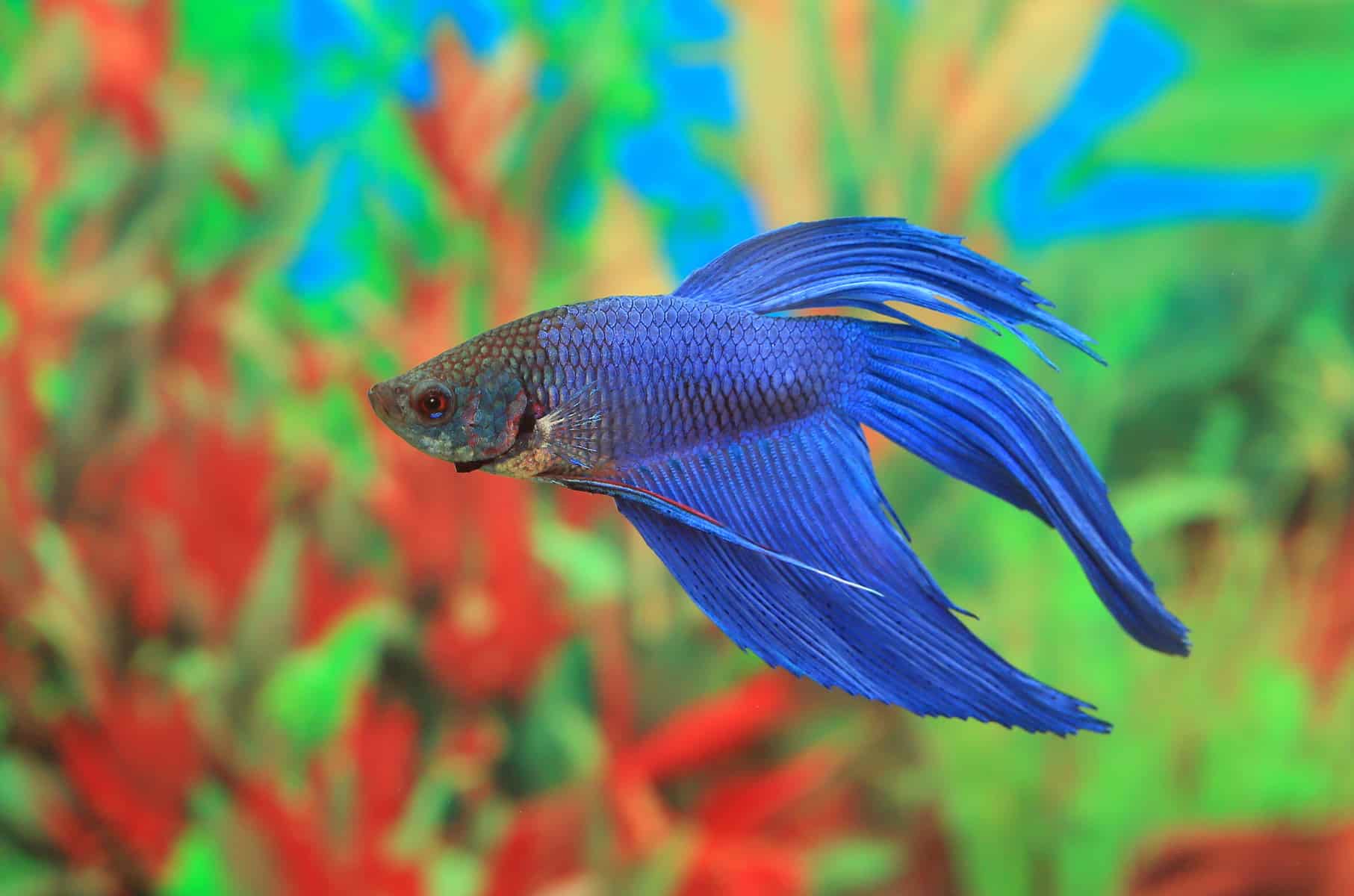Betta fish are pretty resilient creatures and will remain healthy and happy, as long as you provide your fishy friend with a clean tank, the correct water parameters, and a balanced, nutritious diet. However, bettas are especially susceptible to a condition that’s commonly called “Cotton Wool Disease.”
In this comprehensive guide, we look closely at Cotton Wool disease and give you all the information that you need to recognize, treat, and prevent the condition.
What is Cotton Wool disease?
The cotton Wool disease is also commonly known as Columnaris, Saddleback disease, Guppy disease, and Cotton Mouth disease, and it has the scientific name Flexibacter columnaris.
Many novice fish keepers think that Cotton Wool disease is caused by a kind of fish fungus, largely because of the bacterium’s cotton-like appearance, hence its common name. However, the condition is actually caused by a gram-negative rod bacterium called Flavobacterium columnare. The cotton wool disease is very common in tropical aquarium fish, especially anabantoids, such as bettas.
In fact, fungus on fish is pretty rare in betta fish, although it can sometimes be seen affecting dead tissue.
How to recognize Cotton Wool disease
Flavobacterium columnare presents in a variety of appearances, but it’s quite easy to spot on your betta fish, especially as the disease develops. The cotton Wool disease manifests itself in several recognizable stages.
Skin irritation
The sick fish may flick or rub its body against the substrate, tank decorations, and plants. However, that can also be a sign of parasitic infections such as Ich. If your fish begins to develop a rash of tiny white spots, the condition is almost certainly Ich, not Columnaris.
Fading colors
A poorly betta fish will begin to lose his bright colors, and your usually vividly colored betta will lose all his luster, appearing faded and pale.
Fin damage
The first sign that something is wrong with your betta is usually that his fins will appear ragged and frayed. Now, that’s also a symptom of another bacterial disease, fit rot. However, in fish with fin rot, the whole fin gradually disintegrates, and eventually, the fish’s body starts to rot away.
Ulcers
The next thing you’ll notice is that your fish begins to develop sores and ulcers on his skin. That’s a clear sign that your betta has Columnaris, not fin rot.
Cotton-like growths
Look out for a yellowish-brown or whitish-gray fluffy-looking growth on the fish’s mouth, fins, or body. The bacteria colonies look like cotton-like tufts, threads, or link, and may extend right across the top of the fish’s body, rather like a saddle. Other signs of Cotton Wool disease that generally accompany the cotton wool growths include reddening around the site of the infection, poor appetite, and general inactivity.
Gill necrosis
If betta columnaris is allowed to progress untreated, your betta fish’s gills will begin to change from their usual healthy pink to an unhealthy brownish color. That color change can mean that the skin surrounding the gills is dying, and necrosis is setting in.
If the disease reaches this stage, you will have an extremely sick fish that is clearly struggling to breathe. Once gill necrosis occurs, treating Columnaris becomes much less likely to have a positive outcome.
Other symptoms of columnaris
In addition to the symptoms above, there are some other indications that your betta may have Cotton Wool disease.
- The betta’s mouth, head, gills, and the dorsal area will develop a coating of slimy mucus. The mucosa is produced by the fish’s immune system in an attempt to shift the Flavobacterium columnare organisms from the skin and out of the betta’s system.
- Your fish’s lips may start to swell. If you don’t treat the disease quickly, the fish’s mouth will start to rot away.
- If the betta’s mouth is infected, he will stop eating.
If your betta is attacked by a particularly virulent form of the disease, his head may start to rot away. Unfortunately, once the disease has reached this stage, treatment is pretty futile, and the kindest thing that you can do for your pet is to euthanize him.
What causes columnaris?
There are several causes of Cotton Wool disease, all of which are very preventable through good housekeeping and aquarium maintenance.
Poor water quality
Columnaris is generally caused by high levels of ammonia and nitrites in the tank or excess nitrate in the water, usually due to poor maintenance and aquarium cleaning practices. Decaying fish waste, uneaten food, and rotting plant matter can also contribute to poor water conditions, as can overstocking.
Stress
Bettas can also be more vulnerable to attack by bacteria and parasites if they become stressed. There are many things that can stress your fish, including unstable water conditions, sudden changes in water temperature, unsuitable or aggressive tankmates, poor diet, and even boredom. As with all fish species, prolonged stress impacts on the animal’s immune system, weakening the creature’s ability to fight off diseases.
Lack of oxygen
It’s also thought that poorly oxygenated water can contribute to the growth of harmful species of bacteria in the aquarium. So, you should add an air stone to your setup and make sure that you maximize the water surface area that’s available for gaseous exchange by not overfilling betta bowls.
So, be sure to check your water quality regularly by using a water testing kit that you’ll find in most good pet stores or online. Usually, carrying out partial water changes and cleaning your substrate using an aquarium gravel vacuum will keep water toxin levels under control.
New fish added to the tank
If you’re planning to add new fish to your betta’s tank, you must quarantine the new arrivals first. Fish that you buy from a fish store or pet shop are often kept in cramped conditions on display inside the store. Also, all fish that are stocked by fish stores will have been transported to get there, often over long distances. Both situations can severely stress the fish, leading to outbreaks of disease, which you could unwittingly transfer straight into your betta tank.
Place new fish in a separate quarantine tank for at least two weeks before introducing them to your main tank. That way, if the fish show any signs of disease, you can treat it and wait until the fish are symptom-free before moving them to your betta tank.
Poor diet
Bettas are primarily carnivorous, although they do benefit from the inclusion of a small amount of plant or vegetable matter to their diet. If you feed your fish too little meaty protein, he may become weakened and unable to fight off diseases. So, make sure that you provide your betta buddy with the right diet, and don’t overfeed him.
How to treat columnaris
It’s vital that you treat your betta immediately if you suspect that he has Cotton Mouth disease, as leaving the disease to progress unchecked can be fatal for your fishy friend.
Quarantine your fish
Your first action should be to move your betta fish to a quarantine tank. Fill the tank with conditioned tap water and make sure that there’s nothing in the tap that could cause injury to your sick fish.
Water temperature
Flavobacterium columnare flourish in warm water, so it’s often effective to gradually lower the water temperature in your betta’s tank over a few days. You can safely reduce the temperature in your betta’s tank to between 75˚and 77˚ Fahrenheit temporarily. That’s within your fish’s tolerance, but it will help to weaken the bacteria in conjunction with the drug therapy regimen that you’re using to treat your pet.
Drug therapy
There are several suitable aquarium antibiotic products that are suitable for the treatment of gram-negative bacterial infections, including Mardel’s Maracyn-Two, which is very effective. To combat secondary infections, we recommend that you use Maracyn in conjunction with Maracyn-Two. Before treating the water, you need to remove any chemical filtration media from the filter system.
Oxytetracycline is a very powerful antibiotic that can be used to treat Flavobacterium columnare, and you can find this drug included in some specialist medicated fish foods. If your betta is still eating, it’s worth offering him a medicated food, which will get the drug into his system quickly, making a full recovery more likely.
When using all forms of medication, be sure to read the manufacturer’s dosage instructions on the packaging, and if you’re unsure of how to use the treatment, ask for advice in your local fish store.
Add aquarium salt
The addition of aquarium salt to the water will help to reduce your betta’s stress levels and boost his immune system.
Again, read the instructions on the packaging before you treat the water with aquarium salt, but a general rule of thumb is to use one teaspoon of salt per five gallons of water.
Water changes
During your betta’s treatment, carry out 25% water changes every few days in your display tank. That will get rid of any remaining Columnaris bacteria from the environment before you return your fish to his home.
Before redosing the tank, always carry out a 100% water change so that you don’t accidentally overdose your fish.
Does columnaris treatment work?
Provided that you have caught Cotton Wool disease early enough and given your betta the correct treatment, he should begin to show signs of recovery pretty quickly.
However, if your sick fish is not showing signs of improvement, you may need to start treating him with a stronger antibiotic product, such as Kanamycin.
Prevention of Columnaris in betta fish
Of course, by far, the most effective method of treating Columnaris in betta fish is to prevent your pet from falling victim to the disease in the first place. There are quite a few practical ways in which you can keep your pet safe:
Don’t overstock your tank!
First and foremost, don’t be tempted to overstock your tank. That can easily happen if you keep your betta in a nano tank. Adding a few tiny tetras or minnows and a couple of shrimp may seem like a good idea to provide your betta with some safe company and enhance your aquarium display, but that could spell disaster for the environment in the tank.
All living creatures produce waste. Your tank’s filtration system processes that waste, as well as leftover food, plant debris, and general detritus, keeping the water clean and healthy for your fish. If you overload the filter by keeping too many fish in the tank, the beneficial bacteria that live in the filtration media can’t cope with the increased bioload, leading to poor water quality. That’s when harmful bacteria, including Flavobacterium columnare, can proliferate, potentially causing problems for your fish.
Remember, as a general rule of thumb; you should allow one gallon of water per inch of fish in the aquarium.
Keep the tank clean
That sounds obvious; however, even though the water in your aquarium may look crystal clear, it could still contain dangerous waste chemicals and bacteria.
So, you must regularly remove excess algal growth from the tank, as well as vacuuming the substrate to get rid of fish waste, uneaten food, and detritus that provides the ideal breeding ground for colonies of harmful bacteria.
Carry out weekly water changes
Get into the routine of changing around 25% of the tank water every week. That helps to remove bacteria and excess nitrates, keeping the environment healthy for your betta.
Quarantine new fish
Before you put any new fish into your tank, you should place them into a quarantine tank for at least two weeks. Observe the fish carefully for any signs of disease, and treat them accordingly, only introducing the new arrivals to your main display tank when you’re confident that they are healthy.
Wash plants and decorations
Plants and tank decorations can harbor bacteria, including Flavobacterium columnare. So, be sure to rinse all plants, new substrate, and ornaments in a saline solution before you put them into your main tank.
Choose tankmates carefully
Stress is a major contributing factor in fish diseases. Stressed fish have a compromised immune system, and that can make your betta fish more susceptible to bacterial infection and attack by parasites.
Often, an environment that contains aggressive fish is a stressful one for all the occupants, including the aggressor. So, if your belligerent betta tends to bully his tankmates, you should remove them as soon as practically possible. Some very feisty bettas are simply happier when kept alone, provided that you give them lots of toys, plants, etc., to keep them amused.
Feed a correct, balanced diet
Bettas need lots of meaty protein in their diet to remain healthy.
Although bettas love live food, it’s usually safer to feed them frozen bloodworms, mosquito larvae, brine shrimp, and the like. Live food can contain bacteria, which you could inadvertently introduce to your betta’s tank.
In summary
The cotton Wool disease is a common condition that can affect your betta. Cotton Mouth, as the disease is also called, is caused by the Flavobacterium columnare bacteria and affects most species of tropical aquarium fish.
You can prevent Columnaris by keeping your fish tank water clean, carrying out regular partial water changes, feeding your betta a correct and balanced diet, and taking steps to ensure that your betta fish doesn’t get stressed. Check your fish often for signs and symptoms of diseases and infections, and start treatment early to give your fish the best chance of recovery.





















